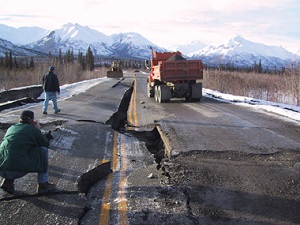
Structurally damaged house resulting from permafrost degradation.
Engineering geology applies the science of geology to understanding the engineering considerations of geologic materials, geologic hazards, and other geologic problems for society. Engineering geologists identify where geologic processes are most likely to have an adverse impact on humans, the structures we build, and the environment, and assure that the geological factors relevant to the location, design, construction, operation, and maintenance of engineering works are recognized and accounted for.
Here at the Alaska Division of Geological & Geophysical Surveys we determine the potential geologic hazards to buildings, roads, bridges, and other installations and structures, and the locations and supplies of groundwater and construction materials. We collect, analyze, and compile geologic data useful for engineering and hazard risk-mitigation purposes, and hydrologic data needed for managing Alaska's water resources. We also advise other DNR divisions and state agencies regarding water resources and potential hazard risks to proposed developments and land disposals.
In many areas of the state, Alaska lacks the fundamental geologic data needed to guide the proper development and implementation of building codes, land-use zoning, right-of-way siting, and contingency planning for natural hazards events. Our work addresses these issues through a variety of efforts.
Surficial-geologic maps portray the distribution of unconsolidated surficial-geologic materials and provide information on their engineering properties and potential as sources of construction materials and placer minerals.
Engineering-geologic maps depicting construction materials resources are useful for building infrastructure to support resource exploration and development, and for locating valuable placer-mineral deposits.
Groundwater analysis and aquifer modeling and mapping in oil and gas basins and other areas of high development potential are essential to ensuring an adequate and safe supply of water for development and resource access.

Road damage caused by Alaska's November 3, 2002, earthquake on the Denali Fault. Photo credit: Alaska DOT&PF.
Studies of major geologic hazards such as earthquakes, active faults, coastal flooding and erosion, and tsunamis result in reports outlining potential hazards in susceptible areas.
DGGS engineering geologists mitigate risks to public safety and health by providing information on geologic hazards, and lower the costs of construction design and improve planning to mitigate consequences arising from hazardous geologic events and conditions.